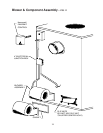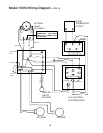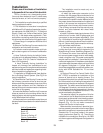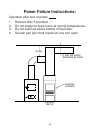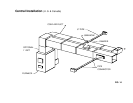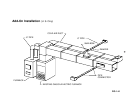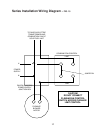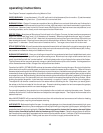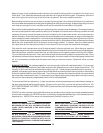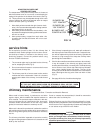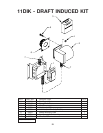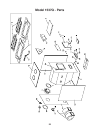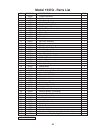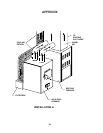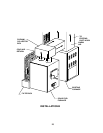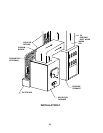
Add a thin layer of coal (preferably smaller chunks) to the wood fire, being careful not to disturb it too much or cut
off the draft. Then, add a second heavier layer after the coal is ignited and burning well. If necessary, add a third
layer to bring the coal up to the top of the front liner (not above!). Be sure to close the ash door.
Before adding further fuel, be sure to leave a red spot of glowing coals in the center of the firebox to insure that the
fire has not been smothered and to help ignite the gases given off by the new charge. A deep charge will give a more
even heat and a longer fire, but it may take one to two hours before the whole bed is fully ignited.
When the fire is well established and the room is becoming warm, partially close the dampers. Some experimenting
will have to take place with each particular setting of all dampers and controls as the chimney provides the draft
necessary to not only exhaust the smoke, but to pull combustion air into the heater as well - and no two chimney's
perform the same. Under ideal draft conditions one should be able to turn the secondary air supply on the feed door
(some models) to a near closed position - but leave the ash pit damper at least partially open to prevent the fire from
going out. Adjust the stove pipe damper to reduce the draft on the fire. With anthracite there will be short blue flames
above the coal, except when the fire is started or a new charge is added. If, however, there is no flame then the
fire needs more air from the bottom (unless it is near the end of its burn cycle and needs to be recharged).
Only when the coal is burned down to half its original depth it is time to add fresh coal. When doing so, open the
stove pipe damper and turn the thermostat damper to high, which will allow the fire to burn off any accumulated gases.
Open the feed door, and with a small rake, hoe, or hooked poker pull the glowing coals to the front of the firebox.
Try not to disturb the fire too much. Next, add a fresh charge to the back being careful not to seal off the top. Close
the feed door, but leave the spin damper (or thermostat) open for a few minutes until the volatile gases have burned
off. It is not necessary to shake down the ashes each time you refuel the furnace. Experience will be your best
teacher.
BANKING THE FIRE: For extended operation, such as overnight, the fire will need to be banked. To do so heap
coal up along the sides and back of the firebox so that the fire gradually burns it over a longer period of time. The
intensity of the fire will also be reduced without letting it go out. Follow the same procedure as for refueling. If
possible, avoid shaking, as a heavier layer of ash will help reduce the intensity of the fire during this time. After loading
let the fire establish itself for about 30 minutes. Then close your damper and automatic control to the point where
the house does not become too cold. It is important that you begin banking early enough before retiring or leaving
that you can make necessary adjustments after the fire is well established.
To revive a coal fire that is almost out, (1) open the ash door and stove pipe damper and close the spin damper on
the door to get a good draft through the grate. (2) place a thin layer of dry coal over the entire top of the fire. DO
NOT POKE OR SHAKE THE FIRE AT THIS TIME! (3) after the fresh coal has become well ignited shake the grate
(just a little), refuel.
DO NOT burn coke, charcoal, high volatile bituminous coal, sub bituminous, lignite or cannel coal (sometimes called
channel coal or candle coal). NEVER burn wax or chemically impregnated sawdust logs - their intended use is for
fireplaces only. NEVER fill the stove or furnace above the firebrick or cast iron liner.
19
CAUTION
GASES THAT ARE DRIVEN FROM FRESH COAL MUST
BE BURNED OR THEY WILL ACCUMULATE AND EX-
PLODE. NEVER SMOTHER A FIRE WHEN ADDING
FRESH COAL.
CAUTION
DO NOT OPERATE WITH THE FEED AND/OR ASH
DOOR OPEN. THIS FURNACE IS DESIGNED FOR THER-
MOSTATIC OPERATION. OPERATION WITH ANY OF
THESE DOORS OPEN WILL OVERHEAT AND DAMAGE
THE FURNACE.
CAUTION
NEVER USE GASOLINE, GASOLINE-TYPE LANTERN
FUEL, KEROSENE, CHARCOAL LIGHTER FLUID, OR
FLAMMABLE LIQUIDS TO START OR "FRESHEN UP" A
FIRE IN THE FURNACE.
CAUTION
NEVER STORE FLAMMABLE LIQUIDS, ESPECIALLY
GASOLINE, IN THE VICINITY OF THE FURNACE.



